Description
Overcoming Cholangiocarcinoma
The Promise of Photodynamic Therapy and Other Innovative Therapies
Cholangiocarcinoma (or bile duct cancer) is a slow-growing yet generally lethal cancer that arises from the tissues of the bile ducts. This cancer comprises about 2% of all cancer diagnoses, and most cases occur in men and women over the age of 65. These bile duct tumors show a highly variable incidence in different parts of the world, a fact that could suggest different causal factors or risk factors. The highest incidence rates can be found in Southeast Asia, and the lowest in Australia. Although primary cholangiocarcinoma is a rare disease, the incidence is increasing on a global scale.
Part 1 of Overcoming Cholangiocarcinoma provides an overview of this bile duct cancer, its causes and risk factors, and research-based strategies for prevention and treatment. Most of the risk factors that have been linked with cholangiocarcinoma are those that entail chronic (long-standing) inflammation of the bile duct. For example, among the main risk factors is primary sclerosing cholangitis (PSC), an autoimmune disorder that results in bile duct inflammation. For patients with PSC, the risk of later developing cholangiocarcinoma is thought to be over a thousand times higher than in the general population, at least in Europe and North America. Inflammatory bowel disease, a condition that often follows PSC, is another major risk factor for cholangiocarcinoma.
Surgery is considered a key treatment for cholangiocarcinoma. But when surgeons cannot completely remove the tumor, they typically try to bypass the blocked area by connecting part of the bile duct before the blockage with part of the small intestine beyond the blockage. To keep the bile duct open, thus maintaining the flow of bile, the surgeon may insert a stent (metal or plastic tube) into the bile duct. Between 5% and 10% of individuals undergoing this operation will not survive, and up to 45% experience serious complications, such as infection or bleeding. The prognosis of patients with cholangiocarcinoma after surgery is quite poor, with a reported five-year survival rate in all patients of less than one in five (20%).
Overcoming Cholangiocarcinoma: The Promise of Photodynamic Therapy and Other Innovative Therapies provides a new perspective on new prevention and treatment strategies that could help reverse the rising tide of this rare but deadly cancer. A central emphasis is placed on the astounding cancer-fighting potential of Photomedicine (light-based medicine). Though the therapeutic applications of light date back thousands of years, it is only within the past few decades that high-tech developments in laser technology as well as non-laser light have enabled the medical profession to realize the true healing potential of light.
Here’s an excerpt from the book:
“The discovery that photodynamic therapy (PDT) could be effective against cholangiocarcinoma began with a single well-documented case published in 1991. The patient was in considerable pain and discomfort. He could not be treated surgically and was offered PDT as a last resort. Repeated PDT sessions were given to illuminate the tumor and margin in combination with the bile drainage procedure called stenting. Despite his grim prognosis, the patient was treated in this manner for many years, and he maintained a good quality of life. Now, that very same treatment approach is fast emerging as the standard of care for all patients facing a diagnosis of cholangiocarcinoma.
“As mentioned in Part 1, complete surgical removal of the cholangiocarcinoma tumor or tumors is widely considered to be the only treatment with a potential for cure. To be successful, however, the surgery is limited to removing small tumors that are confined to the bile duct wall. This means that fewer than half of all cholangiocarcinoma cases can be treated with surgery, let alone cured….
“PDT was embraced early on as an alternative strategy for… increasing the chances of successful treatment. PDT can therefore be used in two important ways for patients with bile duct tumors. First, PDT can be used to help cholangiocarcinoma patients who are considered inoperable become operable (by shrinking the amount of disease and making it more accessible). Second, PDT can result in treatment outcomes similar to those of more extensive surgery, as shown by a recent study in which patients with positive margins who underwent surgery had outcomes no different from those who underwent PDT.
“More than 50% of cholangiocarcinoma cases are considered to be inoperable at the time of diagnosis. At least two randomized clinical trials have demonstrated that patients with inoperable cholangiocarcinoma who undergo PDT have a significant survival advantage over the conventional practice of bilateral plastic stenting. Remember that stenting is simply done to keep the bile duct open so that bile continues to flow and drain periodically. It appears that PDT’s ability to kill cancer cells (and thus clear away tumor from the bile duct) may reduce the buildup of bile and thus help prolong the usefulness of stenting….
“PDT has been used both before and after surgery with some success. When used before surgery, or as a neoadjuvant treatment, it may help shrink an existing disease situation and render the tumor or tumors more readily removable via surgery…
“PDT can also be used for local recurrent tumors following surgery. Some case reports have suggested that PDT may improve survival when the treatment is used for a postoperative recurrent tumor.[1] Another small pilot study involving eight patients with cholangiocarcinoma showed marked destruction of the recurrent tumor. The fact that 75% of patients were still free of disease after two years suggests that PDT merits serious attention as a possible treatment for recurrent bile duct tumors.”
The ebook’s appendix includes a special discussion about two light-sensitizing substances, a dietary supplement called Bremachlorophyll, and a unique medicine called Bremachlorin. Because of its diverse effects against cancer, Bremachlorin-PDT is likely to revolutionize the way Photomedicine is incorporated into modern cancer treatment.
[1] Lee TY1, Cheon YK, Shim CS. Current status of photodynamic therapy for bile duct cancer. Clin Endosc. 2013 Jan;46(1):38-44. OP CIT
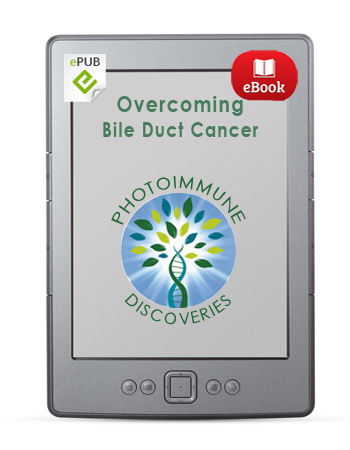
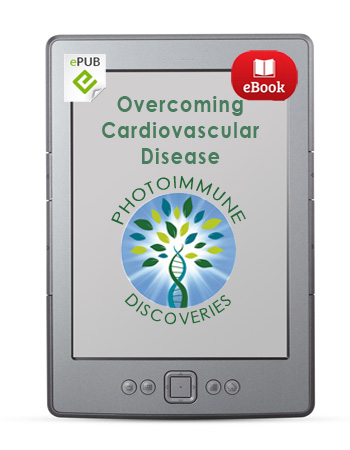
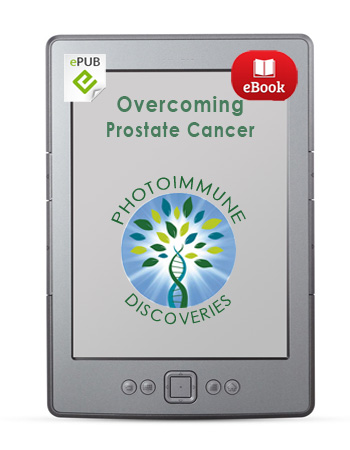
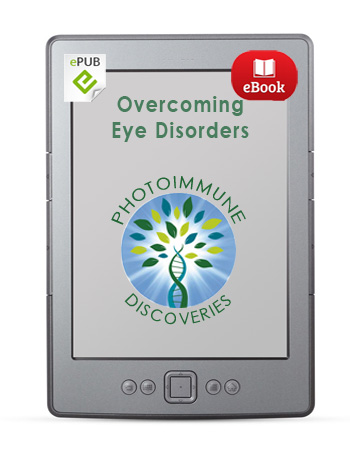
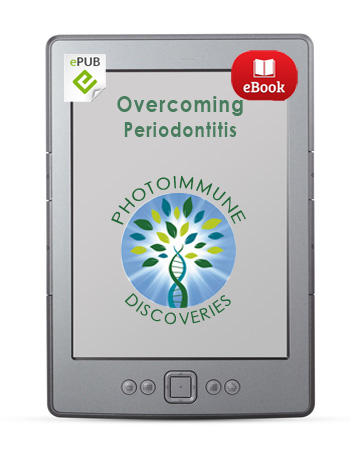

 English
English Français
Français Deutsch
Deutsch Nederlands
Nederlands